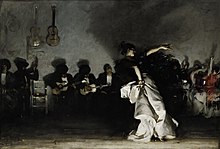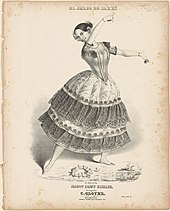Jaleo
The jaleo is a form, a palo , of flamenco, which is now mainly used in Extremadura .
The word jaleo in Spanish means noise, riot; jalear means cheer. In flamenco, cheering and recognition calls are also generally referred to as jaleo .
character
The Jaleo is played and danced in a lively 3-way rhythm. It is related to the Bulería . What he has in common with it is the modal key and the stanza form made up of three eight-syllable verses, of which the first and third rhymes.
The following little poem is a text example:
Vengo de los San Migueles
si no me caso este año
me caso al año que viene.
Échame por la ventana,
el cobertor de ocho duros,
la manta republicana.
I'm from San Migueles
if I don't get married this year I'll get
married next year.
Put
the blanket in the window for 40 pesetas ,
the manta republicana .
history
The first written mention in which the term Jaleo undoubtedly refers to a dance can be found in the Sainete Los Gitanos . This piece was written by an unknown author in 1815. There the Jaleo is compared to a dance called Respingo , which was popular at the time . In the scene the Respingo is rejected as vulgar and the Jaleo is preferred.
At the beginning of the 19th century, Jaleo became particularly popular in Jerez . It quickly developed into a stage dance. Travelers from abroad reported its high reputation. Richard Ford mentioned him in 1831 in a report about a festival in Santiponce . Charles Davillier described it as the first among the particularly noteworthy Andalusian dances. Alexandre Dumas literally mentioned the "Jaleo de Jerez" in 1946 when describing an evening at the theater in Granada . The leading dancers of the time danced it in the theaters of Granada, Málaga , Jerez, Cádiz and Seville . In the 1830s it was presented on the stages of Paris , London and Copenhagen . Mariano Camprubi and Dolores Serrall danced it as a couple in Paris . They set the beginning of a time that is considered to be the golden age of Spanish dance. In the 1850s, the Jaleo de Jerez was performed in the Coliseos of Buenos Aires and Havana . The Jaleo de Jerez was now almost a mandatory part of the repertoire of dancers regardless of their nation. It was danced by Lise and Félicité Noblet , Lucile Grahn , Augusto Bournonville , Fanny Elßler , Mario Pepita and Marie Guy-Stéphan , to name just a few of the most famous names of the time.
Descriptions from that period highlight the sensuality and grace of Jaleo de Jerez. Alexandre Dumas described it as an admirable dance that combines everything: wildness and weariness, love and contempt, sensuality and desire. Théophile Gautier called it the most daring and cheeky of all dances that one could see in the opera, it was phenomenal, scandalous, unimaginable, but delightful. He wrote of curls in the hips and curves in the waist, of arms and legs, thrown in the air, a fit of heated rage, a diabolical undertaking capable of raising the dead. In 1848 a review of a performance by Marie Guy-Stéphan appeared in a newspaper. This shows that the Jaleo de Jerez combined elements of flamenco, escuela bolera and classical ballet. His characteristics can be found today in some dancers in their interpretations of Alegrías .
Another center of Jaleo in the 19th century was Cádiz. When interpreting the Jaleo de Cádiz, Manuela Perea , known as la Nena, stood out in particular . Marie Guy-Stéphan probably also presented it in Paris. Unfortunately, there are no detailed documents about the Jaleo de Cádiz like that of Jerez, so that it is not possible to assess to what extent the two differ.
El jaleo andaluz or jaleos andaluzes were also featured in their programs in the 19th century . Here, too, it is unclear whether it is ultimately the same dance as the Jaleo de Jerez.
References and comments
- ↑ a b Juan Vergillos: Conocer el Flamenco . Signatura Ediciones de Andalucía, Sevilla 2009, ISBN 978-84-95122-84-1 , p. 38 .
- ↑ jaleo | Spanish German. In: PONS online. Retrieved October 15, 2018 .
- ↑ Holly Blazina: How to be a Flamenco Aficionado - What is 'Jaleo'? - Holly Blazina . In: Website Holly Blazina . April 1, 2017 (English, hollyblazina.com [accessed October 15, 2018]).
- ↑ Juan Vergillos: Conocer el Flamenco . S. 128 .
- ↑ duro | Spanish German. Here, duro means a piece of five pesets. In: PONS online. Retrieved October 15, 2018 .
- ^ Manta republicana. Colored ceiling, originally in the colors of the second Spanish republic (example). Retrieved October 15, 2018 (European Spanish).
- ↑ José Luis Navarro García: Historia del Baile Flamenco . Volume I. Signatura Ediciones de Andalucía, Sevilla 2010, ISBN 978-84-96210-70-7 , p. 187-188 .
- ↑ José Luis Navarro García: Historia del Baile Flamenco . Volume I, S. 189 .
- ↑ José Luis Navarro García: Historia del Baile Flamenco . Volume I, S. 190 .
- ↑ José Luis Navarro García: Historia del Baile Flamenco . Volume I, S. 191 .
- ↑ José Luis Navarro García: Historia del Baile Flamenco . Volume I, S. 192 .
- ↑ José Luis Navarro García: Historia del Baile Flamenco . Volume I, S. 192-193 .
- ^ Antonio Barberán: El Cadiz flamenco de mediados del XIX . In: Diario de Cádiz . Cadiz June 16, 2015 (Spanish, diariodecadiz.es [accessed October 16, 2018]).
- ↑ José Luis Navarro García: Historia del Baile Flamenco . Volume I, S. 193 .
- ↑ José Luis Navarro García: Historia del Baile Flamenco . Volume I, S. 194 .
- ↑ José Luis Navarro García: Historia del Baile Flamenco . Volume I, S. 194-195 .


